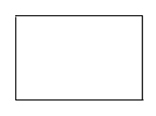|
|
|
One-Point Perspective
Lesson 1
For this lesson, you can use a
ruler or draw freehand. When I’m working in my sketch
book, I work freehand.
1. In your sketch book (or any place), draw a rectangle that represents a wall
that you are facing.
(roughly 1.5 inches by 2.5
inches; or 4cm by 6 cm; or any comfortable size). This is
the back wall,
so don’t make it too large.
|
 |
|
2. THINK: Imagine that you are standing in a
room and facing this wall. If it’s a
normal wall, about 8 feet (roughly 250 cm) high, then a
point directly in front of your eyes would be more than half way up that
wall. Draw a dot on the wall at a point
directly in front of your eyes.
(Actually, when we’re drawing in
perspective, we imagine that we’re looking out of only ONE
eye. But don’t let this worry you.)
It’s a good idea to draw the dot away from the middle of the room. Drawing it in the middle will
just confuse things. |
|
3. This dot is your
vanishing point. I’ll call it VP. When we finish drawing the rest of this room,
the drawing will show a room from the point of view of someone standing in that
room. If we had drawn a dot (vanishing point VP) lower on the wall, we would
end up with a drawing of the room from the point of view of someone sitting in
that room. By placing the VP (the dot in front of your eyes
on that back wall) in different places, we could draw the room from any point
of view that we wish: a fly near the ceiling, a dog on the floor …
We can even draw the VP outside the rectangle, but we’ll
save that for a different lesson. |
4. RULE: You can only
draw three kinds of line:
Sideways (Horizontal lines)
Straight up and down (Vertical lines)
Coming from the VP
(Like spokes on a wheel, or
lines that are aimed at the VP.
It’s the same thing.) |
5. Let’s draw the
wall on the right hand side of that back wall. To do this, we will draw two
lines that come from the VP and go through the corners on the right side of the
rectangle.
|
|
5b. Now, erase the part of each line that’s on the back
wall.
|
|
5c. Another way to think of this would be to place a ruler
on your paper so that the VP and the top corner of the room lie on the ruler.
Then draw only the part of the line that is not on the back wall.
|
|
6. Draw the ceiling
line for the wall on the left. You can do this by placing your ruler on the
vanishing point and on the top left corner of the rectangle, and then drawing
the part of the line that lies outside the rectangle. Or, you can just eyeball
the line so that it points directly at the VP.
7. Repeat the process for the floor line of the left wall.
|
|
8. Congratulations!
You have drawn a room in one point perspective. But, it’s a boring room because
it’s just a box. Let’s make it more interesting. But, remember the rule? You
can draw only three types of line: Vertical, Horizontal, or radiating from the
VP (or aimed at the VP because it’s the same thing.) |
|
|
|
|
|
|
|
|
